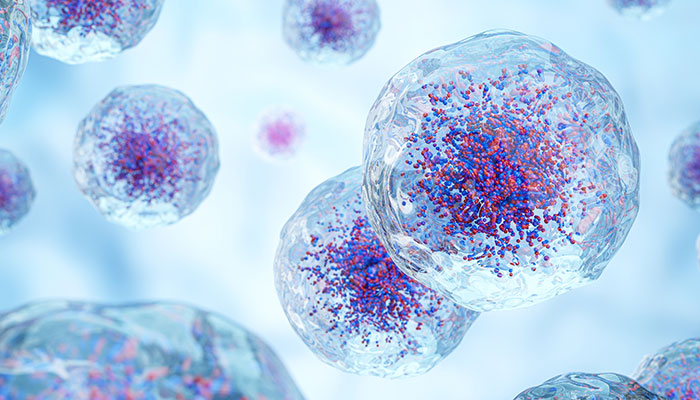HOW CAN WE HELP YOU? Call 1-800-TRY-CHOP
In This Section
Can a Small Molecule Drug Improve Cell Fitness for Transplantation?

Researchers at CHOP identified a way to improve cell fitness for transplantation.
The findings:
Researchers from Children's Hospital of Philadelphia found that exposing hematopoietic stem and progenitor cells (HSPCs) to a readily available small molecule drug during maintenance and expansion in the lab improved cell fitness and could potentially increase the success of procedures such as ex vivo gene therapy.
Why it matters:
Hematopoietic stem cell transplantation (HSCT) is a curative treatment for several noncancerous diseases and serves as the basis for hematopoietic stem cell gene therapy; however, ex vivo growth and modification of cells leads to loss of cell fitness and potency. CHOP researchers are working to understand HSPC programming and signaling to maintain cell health ahead of transplant.
By targeting components in the cells called extracellular vesicles (EVs), the researchers identified a way to prevent the loss of stem cell potency when outside of the body. These findings could enhance the quality of transplant products used in treatments like HSCT and ex vivo gene therapy and improve patient outcomes.
Who conducted the study:
Stephanie Hurwitz, MD, PhD, a hematopathologist at the University of Pennsylvania and research fellow in the Kurre Laboratory, is the study's first author. Peter Kurre, MD, director of CHOP's Comprehensive Bone Marrow Failure Center, is senior author.
How they did it:
The researchers treated HSPCs obtained from humans and mouse models for 24 hours with GW4869, a small molecule drug that inhibits neutral sphingomyelinase-2 (nSMase2). nSMase2 is an enzyme involved in the formation of EVs, a component of cells that is important for delivering messages from cell to cell and maintaining proper cell function.
The researchers' original hypothesis was that blocking EV secretion with GW4869 would be detrimental to the cells, but they found the opposite was true: The 24-hour treatment made the cells stronger and primed to adapt better once they are transplanted.
To evaluate the mechanisms behind their findings, the researchers analyzed the resulting cell cycle profiles after treatment, performing single-cell RNA sequencing and quantitative mass spectrometry on EVs to uncover a mechanism of adaptive stress response that improves the fitness of cells during ex vivo culture.
Quick thoughts:
"We began this study with the intention of deepening our knowledge of the HSPC secretome and its regulatory functions," Dr. Hurwitz said. "However, we not only uncovered a biologic role for secreted vesicles in regulating a stress response in hematopoietic stem cells, but also a potentially translational avenue to explore incorporation of this small molecule drug into protocols for ex vivo gene therapy."
Although there have been many advances in the fields of hematopoietic stem cell transplantation and gene therapy, there are still limitations in the cell quality and quantity, Dr. Kurre added.
"These serendipitous findings have important implications that may help us overcome those limitations," he said.
What's next?
One of the most striking findings in this study was the long-lasting benefit of a 24-hour GW4869 treatment on stem cells, Dr. Hurwitz said. The research team will conduct follow-up studies aimed at understanding how these durable changes occur and their effects during other forms of stress to the blood system, such as chemotherapy or infection. They also plan to explore the use of this treatment as an approach to improve ex vivo stem cell cultures for gene therapy application.
Where is the study published?
The study appeared in the journal Blood.
Learn more:
Read more about the study in this CHOP press release.




